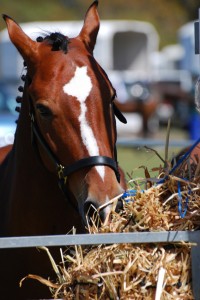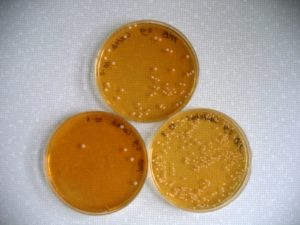Acidosis and Laminitis: Identifying Horses at Risk: EWEN Report Part 3
In this Part 3 of our exclusive report from the European Workshop on Equine Nutrition (EWEN), Dr Mariette van den Berg discusses a recent study by French researchers that evaluated if diet composition (specifically high-fibre or high-starch diets) can modulate the bacterial lipopolysaccharides (LPS) in equine faeces.
This study provided valuable information to an area of research that aims to development a reliable and simple faecal test to identify those horses who are at risk of developing acidosis or laminitis.

Feeding horses rapidly fermentable carbohydrates and abrupt dietary transitions are very common practices in the horse industry.
Gram-negative bacteria are typically your cellulolytic bacteria – fibre fermenting bacteria, or the ones that we want in the hindgut, i.e. ‘good microbes’.
Gram-positive bacteria are the lactic acid producing ones, which we label as the ‘bad’ microbes in the hindgut.
High sugar diets cause Gram-positive bacteria to overgrow and the Gram-negative die off, resulting in massive shedding of their membranes, which contain endotoxins. These endotoxins then can pass from the gut to the blood, and trigger the dangerous laminitis process.
The horse’s hindgut microbiota (the microorganisms that live in the colon and caecum) can react highly and rapidly to abrupt diet changes, with researchers observing these changes as early as five hours after feeding concentrate to horses that were previously on a hay-based diet(1).
Abrupt changes, such as when there is a rapid increase in grass sugars (water soluble carbohydrates, or WSC), or when feeding excess levels of starch-containing grain or cereal based concentrates are known risk factors for the development of digestive and metabolic disorders, such as hindgut acidosis and laminitis(2,3,4).
You may have heard of equine hindgut acidosis (acidosis means the gut content – the fluid – is acidic or has a low pH). This occurs when ‘resistant’ starch escapes digestion in the small intestine, or when the dietary starch, or WSC, concentrations are too high to be absorbed and digested before they reach the caecum.
When the undigested starch or WSC arrives in the hindgut, anaerobic bacteria ferment it rapidly and produce lactate, which quickly lowers the pH of the hindgut, resulting in hindgut (sometimes called lactic) acidosis(5,6).
Various studies monitoring changes in caecal microbial populations of the equine hindgut in response to excess starch or fructan (oligo-fructose) suggest Gram-positive bacteria, such as Lactobacillus spp. and Streptococcus spp.(5,7,8,9) play an integral role during the onset of hindgut acidosis and laminitis.
The direct pathways that trigger laminitis through this acidosis phase are still largely unclear and equine researchers around the world have suggested a variety of theories.
It seems that different active compounds (e.g. amines and endotoxins) that are released by either Gram-positive and/or Gram-negative bacteria could play a direct role (passing from the gut to blood) or an indirect role (by triggering an inflammatory response) in the lead up to a laminitic episode.
 As an example, the overgrowth of Gram-postive bacteria (especially lactobacillus and streptococcus spp.) associated with lactic acid accumulation causes the death of Gram-negative bacteria (your fibre fermenting bacteria), and leads to endotoxin release. Although endotoxin causes widespread inflammatory responses in the horse, on its own it does not induce laminitis.
As an example, the overgrowth of Gram-postive bacteria (especially lactobacillus and streptococcus spp.) associated with lactic acid accumulation causes the death of Gram-negative bacteria (your fibre fermenting bacteria), and leads to endotoxin release. Although endotoxin causes widespread inflammatory responses in the horse, on its own it does not induce laminitis.
A more recent study, however, also observed an increase in specific pathogenic Gram-negative bacteria(9). The authors suggest Gram-negative bacteria develop and contribute to enterocolitis (inflammation of both the small intestine and the colon), pyrexia (fever) and lameness in the carbohydrate overload model of acute laminitis (this was a pilot study so more research is needed to replicate these results).
We do know that lactic acidosis and laminitis can severely impact the wellbeing and performance potential of horses, so monitoring the health of the gut could assist with the early detection of unfavourable changes, as well as helping identify horses at risk.
All the studies mentioned above specifically monitored the caecum of the horse, where most of the fermentation occurs (similar to the rumen of cows and sheep where fermentation takes place).
However, in practice and in a field situation, it is not possible to take samples from the caecum unless we fistulate horses (a fistula is a tubed opening through which we can collect the fluids that seep out of the digestive tract). This is a very invasive procedure that is no longer accepted in many countries and research institutions.
Therefore, researchers are turning to faecal samples as an indicator for what may be happening to microbiota in the horse’s hindgut.
This was the case for my own Master project(10), where we examined faecal pH and microbial populations in Thoroughbred horses during their transition from pasture to concentrates.
EWEN 2016 presentation
At the EWEN 2016 conference, a French research group from Agrosup Dijon (P. Grimm, J.P. Pais de Barros and V. Julliand) presented some interesting results of a study that specifically investigated particles of Gram-negative bacteria in faecal content.
As I mentioned earlier, recent results show besides Gram-positive bacteria, specific harmful (pathogenic) Gram-negative bacteria seem to proliferate in response to a high-starch diet.
The endotoxins (lipopolysaccharides, or LPS) which are found on the outer membrane of Gram-negative bacteria are composed of three structural domains (O polysaccharide, core oligosaccharide and lipid A) which can be measured with the analytical technique called mass spectrometry. (Specifically 3-hydroxymyristic acid, or 3HM, is typically used to calculate LPS concentrations.)
The resulting LPS calculations can be used to identify microbiota changes. The aim of the study by Grimm et al. was to determine if diet composition (high-fibre or high-starch) influences and changes the LPS concentrations in equine faeces.
Methodology
Six adult geldings were used in a 10-week study period that was divided into three phases.During the first phase (3 weeks), horses were fed 100% hay at 2.2% bodyweight (BW) per day. In the second phase (4 weeks), horses received a diet composed of 57% hay and 43% rolled barley in two meals. The grain component was added gradually over five days. Then, in the last 6 weeks, the horses returned to 100% hay diet without transition. The researchers collected faecal samples for analysis four hours after the morning meal on days 10 and 20 in Phase 1 and 2, and on days 10, 20 and 40 in Phase 3.
Results
The results showed LPS concentrations increased progressively when horses changed from a hay diet to hay/barley and were significantly higher 20 days after the transition.
Faecal LPS decreased significantly when horses returned to their hay diet, which was comparable to the first hay period. Nevertheless, the variability in LPS concentration between horses was larger during the hay/barley diet phase, as compared to during the hay periods.
The authors concluded LPS concentrations are very sensitive to diet changes and these alterations may reflect hindgut bacteria composition occurring under the dietary change.
The larger difference in LPS concentrations between individual animals on the high-starch diet shows some horses are more susceptible to starch than others. This is also what we observed in our study10 and highlights the need to include analysis within animals.
Additionally they suggest in future researh, LPS concentrations should be analysed in conjunction with the changes in gram-negative and gram-positive bacteria. The authors also noted only 3HM was used for the analysis and suggest more lipids fractions should be incorporated in the analysis for greater profile of gram-negative bacteria in the faeces of horses.
Nonetheless, they suggest 3HM (for LPS concentration) could be a simple method to assess the dynamics of bacterial profile in the faeces of horses; providing insight into bacterial balance or imbalance.
This is a fascinating area of research that could lead to the development of a reliable faecal test to identify animals that are at risk of acidosis and/or acute laminitis episodes.
For more information check the EWEN 2016 website (http://ewen2016.com/). Proceedings are released under ISSN: 1629-0763.
References:
1.
de Fombelle, A., Julliand, V., Drogoul, C., Jacotot, E., 2001. Feeding and microbial disorders in horses: 1 – Effects of an abrupt incorporation of two levels of barley in a hay diet on microbial profile and activities. Journal of Equine Veterinary Science 21, 439-445.
2.
Garner, H.E., Moore, J.N., Johnson, J.H., Clark, L., Amend, J.F., Tritschler, L.G., Coffmann, J.R., Sprouse, R.F., Hutcheson, D.P., Salem, C.A., 1978. Changes in caecal flora associated with onset of laminitis Equine Vet J 10, 249-252.
3.
Goodson, J., Tyznik, W.J., Cline, J.H., Dehority, B.A., 1988. Effects of an abrupt diet change from hay to concentrate on microbial numbers and physical environment in the caecum of the pony. Appl Environ Microbiol 54, 1946-1950.
4.
Longland, A.C., Byrd, B.M., 2006. Pasture nonstructural carbohydrates and equine laminitis. J Nutr 136 (Supplement) 2099S-2102S.
5.
Garner, H.E., Hutcheson, D.P., Coffman, J.R., Hahn, A.W., Salem, C., 1977. Lactic acidosis: a factor associated with equine laminitis. . J Anim Sci 45, 1037-1041
6.
van Eps, A.W., Pollitt, C.C., 2006. Equine laminitis induced with oligofructose. Equine Vet J 38, 203-208.
7.
Bailey, S.R., Baillon, M.L., Rycroft, A.N., Harris, P.A., Elliott, J., 2003. Identification of equine cecal bacteria producing amines in an in vitro model of carbohydrate overload. Appl Environ Microbiol 69, 2087-2093.
8.
Milinovich, G.J., Trott, D.J., Burrell, P.C., Croser, E.L., Al Jassim, R.A.M., Morton, J.M., van Eps, A.W., Pollitt, C.C., 2007. Fluorescence in situ hybridization analysis of hindgut bacteria associated with the development of equine laminitis. Environmental Microbiology 9, 2090-2100.
9.
Moreau, M.M., Eades, S.C., Reinemeyer, C.R., Fugaro, M.N., Onishi, J.C., 2014. Illumina sequencing of the V4 hypervariable region 16S rRNA gene reveals extensive changes in bacterial communities in the cecum following carbohydrate oral infusion and development of early-stage acute laminitis in the horse. Vet. Microbiol 168, 436-441.
10.
van den Berg, M., Hoskin, S.O., Rogers, C.W., Grinberg, A., 2013. Fecal pH and Microbial Populations in Thoroughbred Horses during Transition from Pasture to Concentrate Feeding. J. Equine Vet. Sci. 33, 215-222.
11.
P. Grimm, J.P. Pais de Barros and V. Julliand Impact of diet on bacterial lipopolysaccharides in equine faeces, EWEN 2016.


Follow Us!